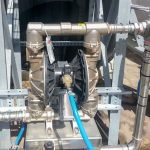We all already know that the pneumatic diaphragm pump is a highly versatile piece of equipment, which can add value to different types of industries and different operations. It can efficiently and safely maintain fluid displacement regardless of the type of material being pumped. However, when this equipment fails, it is very important that those responsible know how to deal with possible problems in order to avoid further damage.
To guarantee the functionality of your pump, it is important to have some essential components in stock, which are:
filter regulator
Low cost and very safe, the filter regulator helps to increase the protection of your pump. Controlling variations in volume and pressure of compressed air inlet, they are essential to ensure that the pump supply occurs as expected. In order for the pneumatic diaphragm pump to last as long as possible, it needs to receive quality air, clean and free of moisture, and the filter regulator is a valuable ally.
Valves
Depending on the type of fluid being transported, potential leaks can cause catastrophic damage, putting the operation and workers at risk. Valves help to isolate the pump when maintenance is required, shutting off the pump and allowing it to be safely disconnected.
Gauges
Knowing how the system is working is essential to monitor the performance of the pneumatic diaphragm pump and, above all, to know how to act in the face of technical problems. With gauges, you can more easily determine where the problem is coming from and how best to deal with it.
Checklist for pump maintenance
Have a checklist for pneumatic pump maintenance can greatly assist operators of pneumatic diaphragm pumps in identifying problems and carrying out repairs. This checklist helps ensure that all components of your operation function properly.
Check out some important steps below:
1. As soon as you receive your pump, check it for damage or defects before installing it. Check all its contents and study the installation and operation manual, which has all the important information about using your pneumatic diaphragm pump.
2. Check the need for maintenance even before it presents problems. Rather than waiting for a problem to happen, create a checklist, which might include:
• Filters;
• Possible leaks;
• Connections;
• Grips;
• Extra components;
• Etc.
With this check, you can predict possible failures and prevent your pump from suffering major damage or greatly impairing its operation.
3. When checking older pumps it is common for more problems to occur, but as with newer pumps they are easy to identify. In general, if there is no excessive air leakage when there is a high load, the pump is in good working order. However, it is important to be careful when pumping fluids that have solids in them, as they can build up and harden. In this case, it may be necessary to disassemble and clean the pump more thoroughly.










